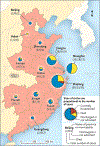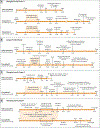Epidemiology of human infections with avian influenza A(H7N9) virus in China
- PMID: 23614499
- PMCID: PMC6652192
- DOI: 10.1056/NEJMoa1304617
Epidemiology of human infections with avian influenza A(H7N9) virus in China
Abstract
Background: The first identified cases of avian influenza A(H7N9) virus infection in humans occurred in China during February and March 2013. We analyzed data obtained from field investigations to describe the epidemiologic characteristics of H7N9 cases in China identified as of December 1, 2013.
Methods: Field investigations were conducted for each confirmed case of H7N9 virus infection. A patient was considered to have a confirmed case if the presence of the H7N9 virus was verified by means of real-time reverse-transcriptase-polymerase-chain-reaction assay (RT-PCR), viral isolation, or serologic testing. Information on demographic characteristics, exposure history, and illness timelines was obtained from patients with confirmed cases. Close contacts were monitored for 7 days for symptoms of illness. Throat swabs were obtained from contacts in whom symptoms developed and were tested for the presence of the H7N9 virus by means of real-time RT-PCR.
Results: Among 139 persons with confirmed H7N9 virus infection, the median age was 61 years (range, 2 to 91), 71% were male, and 73% were urban residents. Confirmed cases occurred in 12 areas of China. Nine persons were poultry workers, and of 131 persons with available data, 82% had a history of exposure to live animals, including chickens (82%). A total of 137 persons (99%) were hospitalized, 125 (90%) had pneumonia or respiratory failure, and 65 of 103 with available data (63%) were admitted to an intensive care unit. A total of 47 persons (34%) died in the hospital after a median duration of illness of 21 days, 88 were discharged from the hospital, and 2 remain hospitalized in critical condition; 2 patients were not admitted to a hospital. In four family clusters, human-to-human transmission of H7N9 virus could not be ruled out. Excluding secondary cases in clusters, 2675 close contacts of case patients completed the monitoring period; respiratory symptoms developed in 28 of them (1%); all tested negative for H7N9 virus.
Conclusions: Most persons with confirmed H7N9 virus infection had severe lower respiratory tract illness, were epidemiologically unrelated, and had a history of recent exposure to poultry. However, limited, nonsustained human-to-human H7N9 virus transmission could not be ruled out in four families.
Figures



Comment in
-
Epidemic of avian influenza A (H7N9) virus in China.Pathog Glob Health. 2014 Jun;108(4):169-70. doi: 10.1179/2047772414Z.000000000206. Pathog Glob Health. 2014. PMID: 24954879 Free PMC article. No abstract available.
References
-
- Gao R, Cao B, Hu Y, et al. Human infection with a novel avian-origin influenza A (H7N9) virus. N Engl J Med 2013;368: 1888–97. - PubMed
-
- World Health Organization. WHO case definitions for human infections with influenza A (H5N1) virus (http://www.who.int/influenza/resources/documents/case_definition2006_08_...).
-
- Yu H, Shu Y, Hu S, et al. The first confirmed human case of avian influenza A (H5N1) in Mainland China. Lancet 2006; 367:84. - PubMed
-
- National Health and Family Planning Commission, People’s Republic of China. Guidelines of case clinical intervention and disease control and prevention of human infection with avian influenza H7N9 virus (in Chinese) (http://www.moh.gov.cn/mohwsyjbgs/fkzs/list.shtml).
Publication types
MeSH terms
Grants and funding
LinkOut - more resources
Full Text Sources
Other Literature Sources
